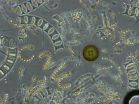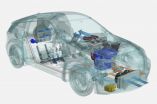Bacterial raincoat discovery paves way to better crop protection
2015-04-13
(Press-News.org) Fresh insights into how bacteria protect themselves - by forming a waterproof raincoat - could help develop improved products to protect plants from disease.
Researchers have discovered how communities of beneficial bacteria form a waterproof coating on the roots of plants, to protect them from microbes that could potentially cause plant disease.
Their insights could lead to ways to control this shield and improve its efficiency, which could help curb the risk of unwanted infections in agricultural or garden plants, the team says.
Scientists at the Universities of Edinburgh and Dundee studied the protective film formed by the common soil bacterium Bacillus subtilis. They found it incorporates proteins that change shape as they reach the film surface. This exposes an impervious surface on the protein molecules, enabling them to slot together like a jigsaw puzzle, to protect bacteria underneath.
The film is able to repel water - which means other potentially harmful molecules also bounce off. Researchers say that being able to control the production of the biofilm in agricultural products could enable improved protection for plants.
The study, funded by the Engineering and Physical Sciences Research Council and the Biotechnology and Biological Sciences Research Council, is published in Proceedings of the National Academy of Sciences. The team behind the finding plans to research further applications for their discovery.
Professor Cait MacPhee, of the University of Edinburgh's School of Physics and Astronomy, said: "Such a controlled shape change in a protein is unusual. This protein only responds in exactly the right way and in the right place. It protects microbes from the outside world, but the ability to control the creation of a water-repellent film has many possible applications."
Dr Nicola Stanley-Wall, of the University of Dundee's Division of Molecular Microbiology, said: "Our findings highlight one of the amazing mechanisms that bacteria have evolved to provide protection from changes in their environment. It also demonstrates the advances that can be made when biologists and physicists work together on a problem of mutual interest."
INFORMATION:
ELSE PRESS RELEASES FROM THIS DATE:
2015-04-13
A new analysis of the chemical make-up of meteorites has helped scientists work out when the Earth formed its layers.
The research by an international team of scientists confirmed the Earth's first crust had formed around 4.5 billion years ago.
The team measured the amount of the rare elements hafnium and lutetium in the mineral zircon in a meteorite that originated early in the solar system.
"Meteorites that contain zircons are rare. We had been looking for an old meteorite with large zircons, about 50 microns long, that contained enough hafnium for precise analysis," ...
2015-04-13
Diversity of life abounds on Earth, and there's no need to look any farther than the ocean's surface for proof. There are over 200,000 species of phytoplankton alone, and all of those species of microscopic marine plants that form the base of the marine food web need the same basic resources to grow--light and nutrients.
A study by a team of scientists from the Woods Hole Oceanographic Institution (WHOI), University of Rhode Island (URI), and Columbia University, published April 13 in the Proceedings of the National Academy of Sciences reveals how species of diatoms--one ...
2015-04-13
ANN ARBOR, Mich. - One of the brain's main jobs is information processing - what is critical, however, is that information in the brain gets transferred to the right places at the right times.
Research on large-scale brain networks by the University of Michigan Medical School reveals that "hubs" in the brain - highly connected regions that like hubs of the airport system - tend to consistently attract information flow.
"Understanding how information transfer occurs in the brain is critical, especially if network hubs are taken off line by anesthesia, tumor or stroke," ...
2015-04-13
This news release is available in German.
How can a pleasant vehicle climate be achieved efficiently? Researchers at the Technische Universität München (TUM) pursued this question in the context of the research project Visio.M funded by the German Federal Ministry for Education and Research (BMBF) with a total of 7.1 million euro. The results of their research show that the potential of energy efficient air conditioning is all but exhausted. And this applies also to gasoline powered cars.
Inefficiency has its advantages, too: In the past, waste heat ...
2015-04-13
Researchers are beginning to explore whether the genetics of patients who experience a placebo effect are different from those of patients who don't. It's well known that people can feel better if they believe they are receiving treatment, but the biological pathways involved are relatively unexplored. In a new review, publishing April 13 in Trends in Molecular Medicine, scientists at Beth Israel Deaconess Medical Center discuss what we know as well as possible ethical issues related to conducting genetic tests to determine whether a patient is a placebo responder.
"Understanding ...
2015-04-13
A new strategy to rule-out and rule-in heart attacks in emergency departments will help physicians treat patients faster, found a clinical trial published in CMAJ (Canadian Medical Association Journal).
Acute myocardial infarction (MI) is a common cause of death and disability around the world. Early diagnosis is critical for treatment and survival.
Swiss and Spanish researchers conducted a clinical trial to determine whether a new technique, previously tested in a small pilot study, would be effective in determining whether a patient has had a heart attack. They enrolled ...
2015-04-13
Family physicians have an important role in advising women about the benefits and risks of egg freezing, argues an analysis in CMAJ (Canadian Medical Association Journal).
"With growing public awareness of social egg freezing, Canadian women may increasingly approach physicians in search of information and advice about the procedure," writes Dr. Angel Petropanagos, Faculty of Medicine, Dalhousie University, Halifax, Nova Scotia, with coauthors Alana Cattapan, Françoise Baylis and Arthur Leader. "Family physicians are uniquely positioned at the front lines of medical ...
2015-04-13
Melanoma cells become drug resistant by using surrounding healthy cells to provide a 'safe haven' from treatment, according to new research* published in Cancer Cell today (Monday).
Around half of melanomas are caused by a mutation in a gene called BRAF. Drugs called BRAF inhibitors treat these melanomas by targeting the faulty gene. But these cancers can quickly develop resistance to these targeted treatments.
Scientists at the Francis Crick Institute, funded by Cancer Research UK, and at the Cancer Research UK Manchester Institute have discovered that a side effect ...
2015-04-13
A drug with the potential to reverse resistance to immunotherapy has been developed by scientists at the University of Southampton. It has shown great promise in pre-clinical models and will be available to patients with certain leukaemias and non-Hodgkin lymphomas in clinical trials later this year.
Targeted drugs made from engineered immune proteins - called monoclonal antibodies - have revolutionised treatment for several types of cancer in recent years. They work by sticking to specific proteins found on the surface of cancer cells, flagging them up to be killed by ...
2015-04-13
BOSTON -Placebos have helped to ease symptoms of illness for centuries and have been a fundamental component of clinical research to test new drug therapies for more than 70 years. But why some people respond to placebos and others do not remains under debate.
With the advent of genomics, researchers are learning that placebo responses are modified by a person's genetics, a discovery that raises important new questions regarding the role of the placebo in patient care and in drug development: How many genetic biomarkers exist? Can the medical field harness the placebo ...
LAST 30 PRESS RELEASES:
[Press-News.org] Bacterial raincoat discovery paves way to better crop protection

